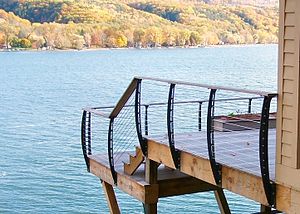Cable railing: Difference between revisions
| Line 3: | Line 3: | ||
==Uses== |
==Uses== |
||
This type of railing is favoured in areas where view of the landscape or ocean would be impaired by other types of railings. Wood railings with spindles, for example, can obstruct views where as cables can nearly disappear. This type of rail was initially |
This type of railing is favoured in areas where view of the landscape or ocean would be impaired by other types of railings. Wood railings with spindles, for example, can obstruct views where as cables can nearly disappear. This type of rail was initially favored for contemporary architecture however it has become popular on homes in recent years. Cable railings are replacing glass panel railings due to their lower maintenance and reduced [[glare|sun glare]]. |
||
==Construction== |
==Construction== |
||
Revision as of 08:24, 26 September 2007

Cable railings or wire rope railings are safety rails that use horizontal or vertical cables in place of spindles, glass, mesh etc for infill.
Uses
This type of railing is favoured in areas where view of the landscape or ocean would be impaired by other types of railings. Wood railings with spindles, for example, can obstruct views where as cables can nearly disappear. This type of rail was initially favored for contemporary architecture however it has become popular on homes in recent years. Cable railings are replacing glass panel railings due to their lower maintenance and reduced sun glare.
Construction
Cable railing requires very rigid frames compared to many other types of railings due to the forces applied to the end posts by tensioning the cables. Cables must be tensioned to provide a rigid as possible condition to satisfy building code requirements. Common frame types are constructed of steel, stainless steel, extruded aluminium or wood.
Cables and Tensioning
Cables are typically constructed of type 316 stainless steel. This type of stainless cable has long been used in the marine industry for yacht stays and guy wires.
References
- Fine Homebuilding magazine
- Ultratec's Guide to Cable Railing Construction
This article has not been added to any content categories. Please help out by adding categories to it so that it can be listed with similar articles, in addition to a stub category. (September 2007) |
